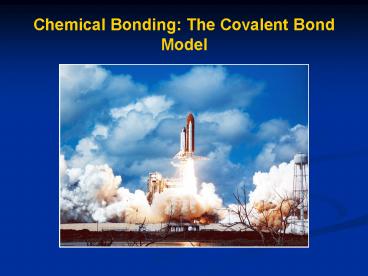Chemical Bonding: The Covalent Bond Model - PowerPoint PPT Presentation
1 / 13
Title:
Chemical Bonding: The Covalent Bond Model
Description:
Chemical Bonding: The Covalent Bond Model Chemical Bonds Forces that hold atoms to each other within a molecule or compound Ionic Bonds Attractive force holding ... – PowerPoint PPT presentation
Number of Views:321
Avg rating:3.0/5.0
Title: Chemical Bonding: The Covalent Bond Model
1
Chemical Bonding The Covalent Bond Model
2
Chemical Bonds
- Forces that hold atoms to each other within a
molecule or compound
3
Ionic Bonds
- Attractive force holding oppositely charged ions
together - Ions can be monoatomic or polyatomic
- Involve charged metal ion (or NH4) and
charged non-metal ion - Results in formation of an ionic compound
4
Covalent Bonds
- Attractive force between a non-metal and a
non-metal - Involves sharing of electrons
- Results in formation of a covalent compound (a
true molecule)
5
Covalent bonding can occur due to orbital overlap
6
Lewis structures can help determine how many
covalent bonds will form
7
What are these?
- Bonding electrons
- Non-bonding electrons
- Single bond
- Double bond
- Triple bond
- Coordinate covalent bond
8
Drawing Lewis Structures of Molecules
- Count the total number of valence electrons
available (add or subtract for polyatomic ions) - Place chemical symbols in tentative arrangement
- Make single bonds
- Fill outer atoms with non-bonding pairs
- Place remaining electrons on central atom(s)
- Check the structure and make double or triple
bonds if needed
9
Electronegativity
- How strongly an atom pulls electrons towards
itself
10
Using electronegativity to predict bond type
- Non-polar covalent (electroneg dif lt0.5)
- Polar covalent (electroneg dif 0.5 - 1.5)
- Ionic (electroneg dif gt1.5)
11
VSEPR Method for predicting molecular geometry
12
Bond polarity and molecule geometry are used
together to predict molecule polarity
13
(No Transcript)































